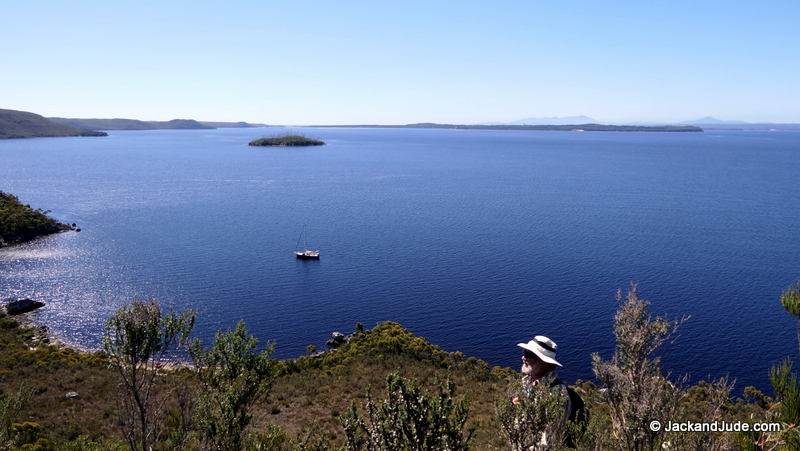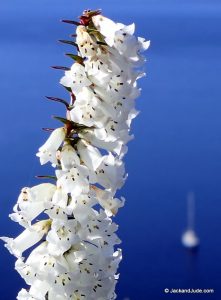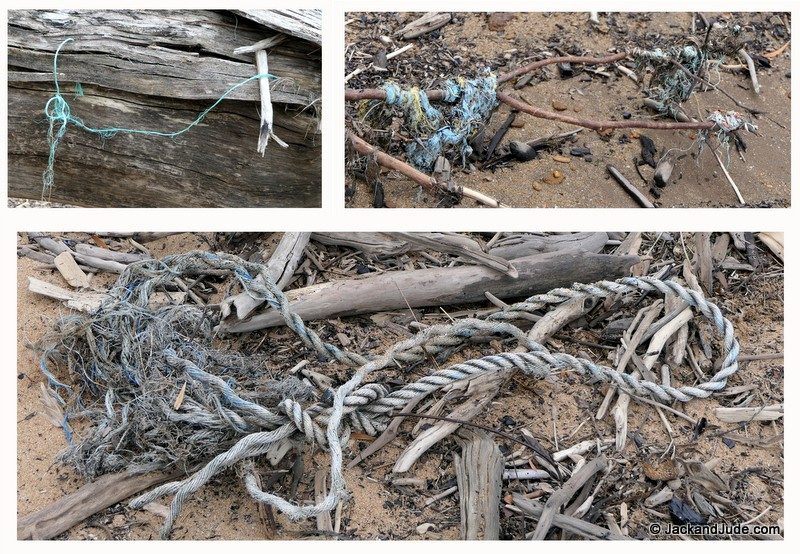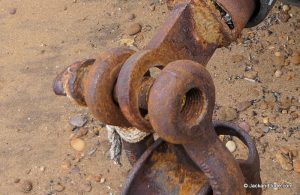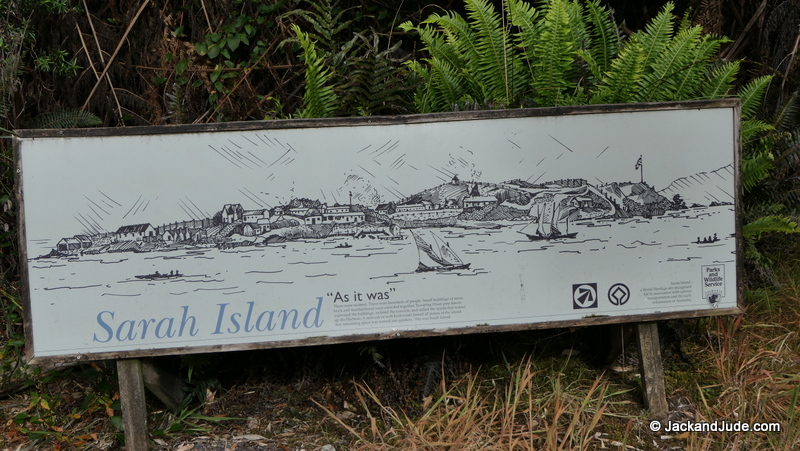December 2018 November 2018 >>
Blog of Jack and Jude
explorers, authors, photographers & videographers
Shakedown cruise with a mission
 Last summer, we got so busy with local events that Banyandah never felt the lumps and bumps of the open sea, and that has left her crew itching for a run across open waters. Outside Macquarie Harbour spreads the Great Southern Ocean where winter storms can generate monster waves taller than many building. Fortunately, it’s a lot kinder in summer, but the elements can still play football with vessels like ours, so we’d better be prepared. We will be turning the YELLOWBRICK Tracker ON before departing on our run around Tasmania.
Last summer, we got so busy with local events that Banyandah never felt the lumps and bumps of the open sea, and that has left her crew itching for a run across open waters. Outside Macquarie Harbour spreads the Great Southern Ocean where winter storms can generate monster waves taller than many building. Fortunately, it’s a lot kinder in summer, but the elements can still play football with vessels like ours, so we’d better be prepared. We will be turning the YELLOWBRICK Tracker ON before departing on our run around Tasmania.
It took a full week to pack away all our clobber and new gear, all the time looking with eager anticipation at a shakedown cruise down harbour. Before unleashing our lady from her winter mooring, we repaired sails and bent the roller-furling headsail back onto its spar, and reinstalled all blocks and sheets from storage, checked the steering cables and gave their turning blocks a squirt of lubricant, lubed and checked our vintage engine, tightened v-belts and greased pumps. Then for good measure, end for ended our anchor chain. Hurrah! After all that, we were ready to hit the engine starter, and Varoom, we were delighted when first piston up fired our straight six roaring into life. Phew! So good to see raw water begin pouring out with the exhaust.
A friendly weather forecast saw us borrow a mate’s car to help refill our larder and booze chest. Then we were gung-ho ready for a week of turning dials and pushing all the buttons, meaning let’s put our lady to work, searching for any weakness.
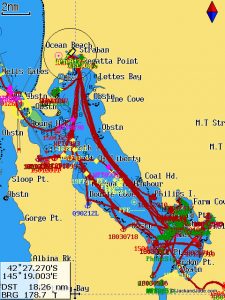 Our GME chart-plotter happily complied when its buttons were pushed, and after a lengthy wait it found our position, so away we went, making yet another track line out of Mill Bay to overlay the multitude of trips made earlier in the year. We happily motored away from Strahan in brilliant sunshine that showered the wide dark waters with sparklers that decorated the awesome reflections of mountain ranges adorned with lush green forests. Our first stop found us back near Betsys Bay under the white granite outcrops of Table Head. Here we found a pleasant surprise.
Our GME chart-plotter happily complied when its buttons were pushed, and after a lengthy wait it found our position, so away we went, making yet another track line out of Mill Bay to overlay the multitude of trips made earlier in the year. We happily motored away from Strahan in brilliant sunshine that showered the wide dark waters with sparklers that decorated the awesome reflections of mountain ranges adorned with lush green forests. Our first stop found us back near Betsys Bay under the white granite outcrops of Table Head. Here we found a pleasant surprise.
Ever since 2012 when the fish farms were allowed to triple in size, Macquarie Harbour has been having problems with the local ecology. Really, how did the government figure that feeding 29,500 tonnes of fish and letting their poop fill the harbour would not damage the pristine environment!
History of Mismanagement
In April 2011, Tassal, Huon Aquaculture and Petuna jointly pitched for an extra 120 hectares each, which would almost double the total lease area in the harbour, from 564 to 926 hectares that would hold lots more fish.
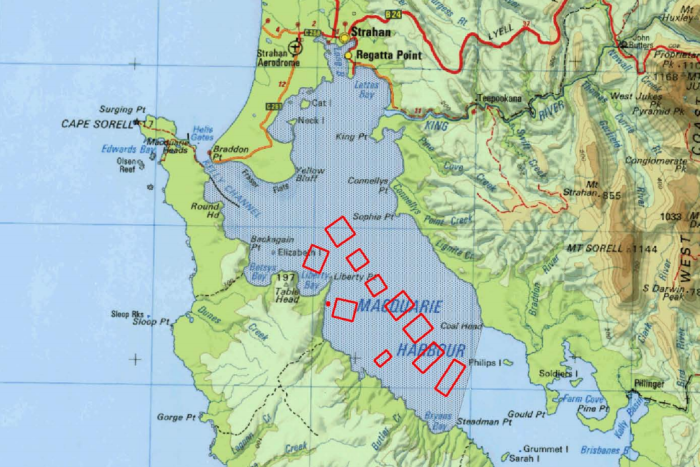
Fish Farm Leases cover 98 hectares of Macquarie Harbour

29,500 tonne at say 2 kilos each = 14.5 million fish
The push, based on an Environmental Impact Study (EIS) completed by a Malaysian company, said Macquarie Harbour could support 29,500 tonnes of fish, and Primary Industries Minister Bryan Green backed the expansion bid as being in line with the industry’s aim to double production by 2030. He also rejected concerns the expansion would threaten the World Heritage Area, citing “extensive” modelling that was “world’s best practice”. But some locals worried the harbour would not cope. Among them, Ronnie Morrison, who founded Southern Ocean Trout: “I did say at the time that if the expansion went as per the EIS, up to 29,500 tonnes, that the environment in Macquarie Harbour would probably completely collapse within five to seven years.” Tragically he’s been proved correct. (How salmon farming pushed Macquarie Harbour to the limit)
Jack, you may know, is the secretary of the local Wildcare group, Friends of Macquarie Harbour and Waterways. So when the locals began finding long lengths of the black poly pipe used by the farms and bits of cages, huge buoys, and myriad of ropes at their favourite fishing and Nature spots, Jack and Jude swung into action making short video clips showing the vast extent of walkabout fish farm trash. Our actions were elevated last year after the locals noticed hairy green algae beginning to cover their piles, barges, and mooring ropes. We produced three rather alarming videos that were first sent to the fish farm companies as well as State Government officials, and then eventually could be found on several environment activists’ websites. These have joined the many other voices that finally found their mark with the EPA reducing fish tonnage for Macquarie Harbour. (past videos: 1/ Scary Gunge – 2/ Fish Farm Trash – 3/ – Fish Farm Gunge)
Our pleasant surprise
Lying to our anchor under Table Head, we didn’t hear the usual hum of fish farm machinery because the leases nearest Hells Gate are now empty and left fallow. These leases are the most affected when northwest gales push the sea through the gate, causing an upheaval of oxygen dead water lying on the harbour floor, which resulted in the death of thousands of fish. Tasmania’s Environment Protection Authority (EPA) confirmed 1.35 million salmon died in Macquarie Harbour in the past year ending October 2018, many of these were in the leases nearest Hells Gate.

Table Head Climb
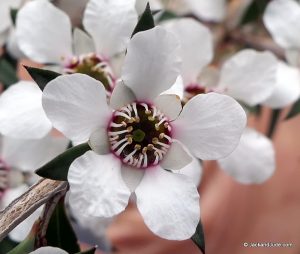 Above the stony beach a massive outcrop of granite beckoned to us with the promise of expansive views up and down the calm enclosed waters, and it didn’t take more than a few minutes to answer that call with a quick row ashore decked out in boots and trekking garb. To a pair of wilderness junkies like us, the steep open slopes covered with tea-tree and buttongrass were balm for our bodies needing some serious physical work, with the added delight that we were dancing through a bevy of spring flowers of varied shapes and colours. The prize, of course after our workout, were massive views over the harbour. But what startled us were how fewer fish farm cages were now in use. No doubt because of the massive fish deaths and the EPA downgrading the tonnage of fish from 21,500 tonnes to only 9,000 tonnes, which is about the original quantity before the expansion, has brought about this change.
Above the stony beach a massive outcrop of granite beckoned to us with the promise of expansive views up and down the calm enclosed waters, and it didn’t take more than a few minutes to answer that call with a quick row ashore decked out in boots and trekking garb. To a pair of wilderness junkies like us, the steep open slopes covered with tea-tree and buttongrass were balm for our bodies needing some serious physical work, with the added delight that we were dancing through a bevy of spring flowers of varied shapes and colours. The prize, of course after our workout, were massive views over the harbour. But what startled us were how fewer fish farm cages were now in use. No doubt because of the massive fish deaths and the EPA downgrading the tonnage of fish from 21,500 tonnes to only 9,000 tonnes, which is about the original quantity before the expansion, has brought about this change.
Returning to Banyandah, you can imagine the elation Jude and I felt when in silence we sucked in the essence of freedom surrounded by the beauty of a golden sun casting its radiant glow upon the 1140 m peaks of mount Sorell just as the eastern stars began to twinkle above them. That night we slept deeply at peace.
Next morning brought a skerrick of wind, enough to roll up the awning then raise all sail for a voyage to one of our favourite spots, our “office” as we call it, the hidden spot that holds the best views of Mount Sorell’s entire length reflected in the flat dark waters of Farm Cove.

Our Office
Eleven months earlier, Jude and I had produced a video at that location which showed massive trash littering the harbour side foreshore, so we set off that very afternoon with cameras in hand to see how clean, or not, the farms were keeping the harbour.
There’s a tiny path linking Farm Cove to the Harbour, which crosses the narrow neck in a lovely short saunter through green man ferns (Dicksonia antarctica) and a variety of fungus and tall eucalyptus, many being standing dead from the 2016 fire that burnt everything from that track south to Gould Point. (Finding the Farm video shows this.)
Gaining the beach, at first glance it looked pristine, and our fears began to ease, until sighting the first length of fish farm plastic rope half buried in the sand. With my camera still tucked in its case, we strolled south for a few more minutes before another potpourri of rope trash had me reaching for my trusty Canon video recorder. At first I just recorded the disappointing batches of trash, but as I did one thing began to draw my attention. Many of the ropes were breaking down from exposure. Modern ropes are made up of hundreds of minute strands of plastic, which when left exposed become brittle and fall to pieces – some were already what are termed microplastics, with the remainder well on their way to being ingested by the local environment. Disappointed and outraged, we thought how dare commercial operations take over the pristine world heritage waters and pollute them with their trash! Notwithstanding the Gunge we now have growing on our vessels, piles and foreshores as a result of the excessive nutrient levels, we also have their bloody ropes landing on the shores and falling to bits.
After spotting a massive black fish farm buoy high and dry ahead, and then seeing that not only had its attaching rope snapped, but that its shackle pin had come undone too, being held by a weak piece of greasy hemp, I exploded in a roar akin to Tarzan’s fearsome call.
Finding all those lost and forgotten ropes meant the farms were not looking after the well-being of the harbour, and finding their buoy in such a miserable condition indicated they didn’t even care about maintenance. Fanning the flames of our annoyance, there has been a lot of PR lately about how the farms cherish the harbour and are expending heaps of cash keeping it clean, using helicopter flights to locate their trash. Folks, you cannot see rope bits from a whirlybird. And you can’t see them from passing boats. You can only see them with boots on the shore, walking it like Jude and I were doing that afternoon. What this means to us is that the farms are more concerned with PR than they are about the health of world heritage Macquarie Harbour. So we decided to make another video and publicize their wanton disregard.
Best viewed in HD – select using settings gear on player
A couple of rainy days followed, allowing us time for our other passion which is writing up our around the world voyage with our two sons when they were teenagers in the nineteen-eighties. Also, Jude braved the icy waters on two occasions to scrape away the inch thick coating of minute mussels and weed attached to our hull, both not known in the harbour before the farms expanded.
Sarah Island
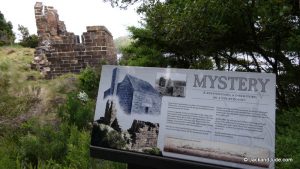 Everything on board Banyandah was performing as expected, and buoyant with happiness we sailed over to Sarah Island for a quiet night followed by a haunting early morning visit to that prison island before the tourist boats started arriving. After that, a lovely favourable breeze gave us a sail-away start from Trevor’s mooring with our destination of another night under Table Head.
Everything on board Banyandah was performing as expected, and buoyant with happiness we sailed over to Sarah Island for a quiet night followed by a haunting early morning visit to that prison island before the tourist boats started arriving. After that, a lovely favourable breeze gave us a sail-away start from Trevor’s mooring with our destination of another night under Table Head.
The zephyr, finding its way over the ridge and into the harbour, let us edge along the farm leases, and as we did that gentle west wind grew just that little bit stronger until we were touching a healthy five knots putting a wide smile on Jude and encouraging us to just keep truckin’ home. Our dessert, a beautiful sail right past the sand spits to our mooring that brought great satisfaction, especially when Jude’s stats showed that we had sailed more than we had motored during those five days away– 28 sailed – 22 motored.
Welcome Home Swallows
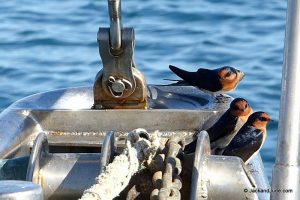 Across the still quiet lagoon reflecting an azure and quartz white sky, our homecoming suddenly lost its carefree bliss with a call to action warding off attackers.
Across the still quiet lagoon reflecting an azure and quartz white sky, our homecoming suddenly lost its carefree bliss with a call to action warding off attackers.
“Incoming!”
“Another at two o’clock,” quickly became a whoosh just missing our ears.
Like Star Wars fighters their assault continued, making our first touch of Banyandah very difficult.
“Get out of here,” Jude yelled waving them away. But that only caused them to circle around for another close fly-by. Darting on spitfire wings, this family of Welcome Swallows definitely did not make us feel welcome back on board our craft after her winter facing Southern Ocean storms. But, after finally gaining the deck, the invasion was more easily beheld.
Eight or ten of the squeaking avian were calling our aft tower their home, while their relatives numbering another half dozen occupied our open ended boom. Later we discovered another pair happily seconded under our bow rollers where there is height enough to build a mud fortress lined with long narrow leaves and the daintiest of breast feathers.

Tucked away under our bow rollers
Thank the powers that decide these matters
That pair must have just finished making their nest and hadn’t laid any of their clutch that can range from two to seven eggs with an average of four. In the other two lodgings we only had found large piles of long slender eucalyptus leaves, some mud, thankfully no eggs.
Discovering that made us feel a whole lot better, especially as the birdies still have time to find a new site and start again.

Long slender leaves and some mud, thankfully no eggs
Last year, same thing happened
In one way, we were blessed to find upon boarding Banyandah after the previous winter, only one pair had constructed a mud fortress weighing down the canvas under our solar cells. Only one, but early starters and there were several eggs, about 18 mm in length and 13 mm in width, with pinkish colour and brown speckles, seen amongst the soft feathers lining their nest. So, last year we left them in peace and we lived harmoniously for the few weeks before tiny chicks could be heard chirping above our heads morning and night.
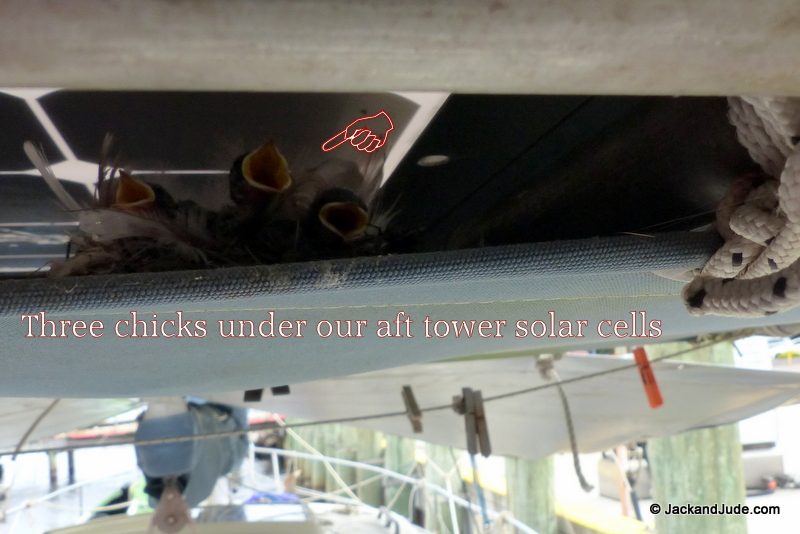
Little Chicks – Big Mouths
Then came the predicament
We wanted to go down harbor. Wondering whether mummy and daddy bird would be able to follow their nest, we first set off for the dock to take on fuel and water. But, alas, mummy and daddy didn’t follow. A calamity – Oh, what to do?
Straight away, Jude went off to find baby bird food, and surprisingly returned rather excited with the news that small spiders lived in colonies around the shore lighting, and picking up a pair of tweezers and small container with a lid, she turned about hot in pursuit of baby bird food.
So sad. All for naught. Not for lack of insects. No, no, Jude had collected around fifty that were crawling all over themselves at the bottom of the container, but even though the babies greedily devoured several, they died overnight, perhaps from the cold without mummy and daddy to protect them from the night chill.
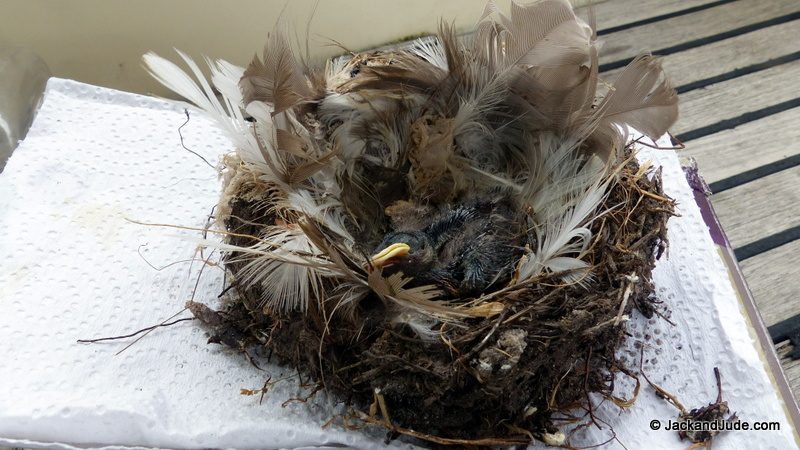
Heart broken, we wondered what more could we have done, and felt miserable, promising we’d not go through that again, but feeling we would. So, Karma has smiled upon us all this year.
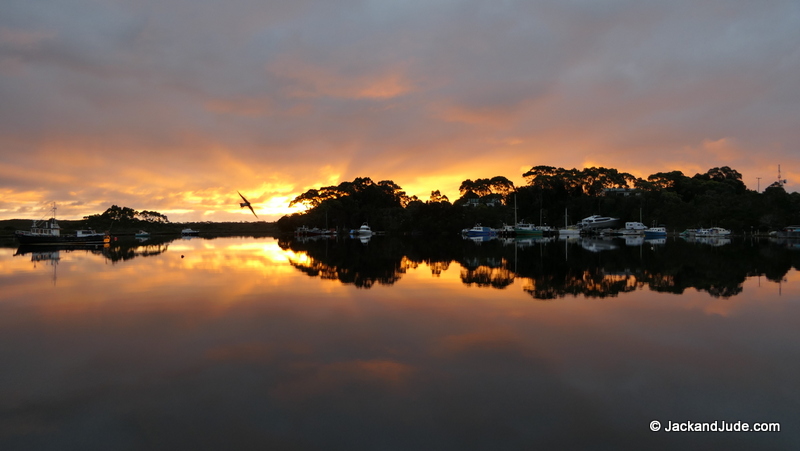
Our feathered friends still swoop the skies around our vessel

